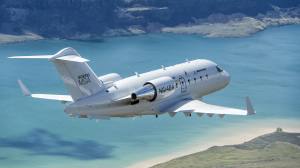If a P-8 Poseidon is beyond your price range for a maritime surveillance aircraft, Boeing has an alternative.
The Maritime Surveillance Aircraft, or MSA, as it is being called, does not yet have the moniker of a Greek god, but ever since Boeing unveiled the concept at the Farnborough Air Show in 2012, it has been assembling a team with a distinct Canadian flavour.

“In less than two years we were able to build a fully missionized aircraft, which is fast in this day and age,” said Matt Carreon, who leads business development for Boeing Military Aircraft. “We also invested our own money to build the demonstrator. It is an innovative approach to build a near-production aircraft to showcase the capability. This is not a prototype, this is a fully missionized aircraft that can do the mission tomorrow.”
The aircraft features a sensor package that includes Active Electronically Scanned Array multi-mode radar, high-definition Electro-Optical/Infrared camera, and advanced electronic support, as well as interoperable data links, high-bandwidth line-of-sight and over-the-horizon communications, and high resolution dual-touch screen work stations.
Carreon said the Challenger was well suited to the task because of its capability and low operating costs.
“We chose the Challenger because of the power, cooling space, payload, speed, endurance, and range to host ISR mission systems, sensors and communications equipment. And it also has the growth capability to make changes in the future.”
Likewise, Field Aviation fit the bill because of its extensive modification experience, notably on three Challenger 604s for the Royal Danish Air Force. Brian Love, the company’s chief commercial officer, said the conversion model is one it has been using “successfully for the last 40 years. We are a big believer in the market, in the model, and obviously in Boeing as a partner.”
At a briefing at CANSEC, Carreon said the demonstrator has been well received by military audiences in Poland and elsewhere in Eastern Europe. Boeing has predicted a market as large as 200 aircraft. The question, of course, is whether it has a future in Canada.
With the CP-140 Aurora preparing to enter definition for Block 4 of its incremental modernization program that will take the aircraft out to 2030, the MSA is not be a replacement option. But Carreon does see a complimentary role.
“Anyway we can support [DND’s] plan for the CP-140, we will,” he said. “The MSA could be a solution by either offsetting their flight hours or reducing the flight hour stress on the CP-140. When you combine that with the low operating costs of the MSA, you have a very good solution for Canada. Our initial analysis shows that you can save over a quarter billion dollars over the next 10 years by going with an MSA/CP-140 solution.
Love notes that the Royal Australian Air Force operates both CP-140s and Dash-8s for coastal patrol and is now acquiring four Challengers “into a similar program. The cost analysis on the CP-140 versus the Dash 8 is something like 3.90 per square nautical mile patrolled versus 31 cents, including the acquisition costs of the aircraft.”
Furthermore, the aircraft has a global commercial market, reducing the cost of maintenance and spare parts.